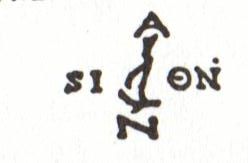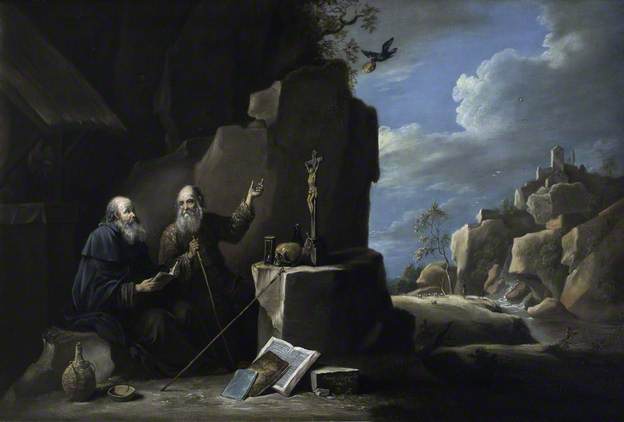Back on track
By inverting the glyph on one of the fake parchments can you see the name of a certain English Sea Lord that has something to do with a lost biblical treasure and sounds like ANSiON?

It is all relatively simple once you know the context of it all as the clues are all there in plain sight. Shepherds of Arcadia II = Shepherds Monument.
The next painting is a bit more difficult to track down as David Teniers the Younger did multiple paintings depicting St Anthony.
Below on the left is an authentic painting by Teniers of ‘St Anthony and St Paul in the Desert’. On the right is a version that was owned by Lord Palmerston. It was at Broadlands at least since 1791 when it appeared listed in an inventory for there. It was sold to Countess Mountbatten in 1942 and moved to Shugborough Hall.
Strangely a copy of this painting already existed at Shugborough Hall. It was executed by Ann Margaret Coke who was an accomplished artist in her own right. Coke had married Lord Thomas Anson in 1794. This painting below is the Coke copy.

A not so close examination of the version of St Anthony and St Paul obtained from Lord Palmerston and suggested by the Coke copy reveals it to contain a clever trompe le oeil of a bear. If you follow to where St Paul is pointing, it is not towards the bird delivering the bread, it is actually to the head of a rather large bear. This is rather interesting as the bear and the constellation of Ursa is the esoteric symbol for the mythical Arcadians. Known as the Bear Race they were guardians of the Ark of the Covenant.
St Anthony appears with a white Tau painted on his shoulder. On paintings this is not unusual as it was a convention among artists to add this as an identifying mark so you knew you were looking at St Anthony the Great. There is also a date (XVII JANVIER) identified on Marie Hautpoul’s headstone that gets raised in most stories about Rennes le Chateau as being somehow important for finding the treasure. This is January the 17th and happens to be St Anthony’s Day. It is also one of the days Cornelius Webb was on the island retrieving the treasure. Given the codes relate to astronomy, one might suspect this day might be when a certain heavenly alignment occurs that points to the treasure.
The paintings associated with Rennes le Chateau are of persons pointing and these are indeed clues telling you to look at something. The problem is, over the short time the story of Rennes le Chateau has been with us, the focus has been concentrated on the Shepherds of Arcadia II somewhat in isolation to the Teniers’ painting so the combined messages these two paintings give has been missed. The first message is given by the Teniers’ painting via St Anthony who is telling you to look at the Stone Arcadians by his pointing to the Stone Bear. The Stone Arcadians are the four shepherds sculpted on the Shepherd’s Monument at Shugborough Hall. They in turn are pointing to something in their scene.
In the end, the whole thing for Rennes le Chateau via the paintings, headstones and clues is just ‘Look to Lord George Anson and his Shepherds Monument. Use the navigational data given on the Hautpoul headstone there’.
The roman numerals that were important to use if the mystery was to be solved?
Can you recall them appearing on some treasure maps related to all this?
The real codes of Rennes le Chateau
The Hautpoul headstone specifically gives 6 then 7 so this means that 67 is a key number to be used for decoding.
MDCOLXXXI on the headstone taken as 16081 is recognizable as a permutation of the Golden Section 1.618. But as it is specifically given as 16081 again, it means it is also a key number.
Running down the encoding permutations for the numbers,
42+67= 109, 109-90 degrees = 19 degrees agee (lat)
180 degrees-42 = 138 degrees ante (long)
16081 divided 67= 240, then add the first key number given 6 to get the value of 246 which was around the 245.5 for Antares.
This code is again giving the map’s central datum point and the bearing to head.
The ‘shepherdess’ message now needs to be really decoded. Beginning with the word ‘SHEPHERDESS’, this message is taken by many to a reference to Poussin’s painting.
In English this message finishes with the strange words ‘BLUE APPLES’. Of course these are the English words for ‘POMMES BLEUES” because we have to translate it from French which literally is “APPLES BLUE”. But it’s not the translation from French that makes the words nonsensical for in French it still just means blue apples.
As the French words are still nonsensical, this is a strong indication that again a garbled mistranslation of a set of original Latin codewords has occurred. There is the Latin word, ‘DAEMON’ which appears in both the French and English versions.
This is not the only problem as some French words can have more than one meaning. The words ‘PAS DE TENTATION’ in French can mean either ‘NO TEMPTATION’ or ‘ON THE THRESHOLD’. ‘MIDI’ can mean either ‘MIDDAY’ or ‘SOUTH’ and ‘J’ACHEVE” can mean ‘I COMPLETE’ or ‘I DESTROY’.
Things get further complicated if you use idioms that have meaning in one language but cannot be directly translated to another. For example, an English speaker can understand that the phrase ‘fruit of the sea’ means an island. But when the Latin word for the colour ‘blue’ (CAERULUS) can also mean the ‘sea’ and the word ‘apples’ is the same word for ‘fruit’ (POMUM), then there is no way ‘fruit of the sea’ was ever going to survive translation from English into Latin then to French and finally back into English again. It was Harold T Wilkins and giving a deliberately bad latin translation again.
As given in the story,
SHEPHERDESS NO TEMPTATION/ON THE THRESHOLD THAT POUSSIN TENIERS HOLD THE KEY PEACE 681 BY THE CROSS AND THIS HORSE OF GOD I COMPLETE/I DESTROY THIS DAEMON GUARDIAN AT MIDDAY/SOUTH APPLES BLUE.
By a bit of punctuation and the inclusion of the indicated idiom, though still a bit garbled the message now has enough meaning so it can be understood,
SHEPHERDESS ON THE THRESHOLD THAT POUSSIN & TENIERS HOLD THE KEY TO PEACE, 681. BY THE CROSS AND THIS HORSE OF GOD I COMPLETE/DESTROY (solve) THIS DAEMON GUARDIAN (for the) SOUTH FRUIT (of the) SEA (south sea island).
It is just a message to look to the paintings spoken about to solve something about them that leads to an island.
The Hautpoul code does appear to be very early copy of some navigational clues to the treasure that were circulating. It is somewhat unique in that it gives (when you bundle the numbers) 4216081 which means ‘At cipher 42 find the Golden Section’. This is pretty direct if you know the cipher for 42 and what the Golden Section means in regards to the lost treasure.
The phrase ‘HORSE OF GOD’ may have been then some metaphor for the ship’s name ‘Unicorn’ as suggested by ‘the spokesman for the Priory of Sion’ (hiya Nic). It may have also been a metaphor to get you thinking about the HORSESHOE.
Indeed in the famous poem associated with this, ‘Le Serpent Rouge’, Stanza 8 (Virgo) says,
“I was like the shepherds of the celebrated painter POUSSIN puzzled by the enigma of “ET IN ARCADIA EGO.” Would the voice of the blood form an image of our ancestral past. Yes, a light of inspiration floods my mind; now I understand. I know now the fabulous secret and what is more amazing is that when the four knights moved, one of the horses left four hoofprints in the rock. Here is the sign which DELACROIX has given in one of the three paintings in the Chapel of Angels. There is the seventh sentence which a hand has traced: “DELIVER ME OUT OF THE MIRE, AND LET ME NOT SINK.” Two times I.S. embalming and embalmed. Miraculous vessel of the eternal White Lady of Legends.”
The Trick of Fate
Here occurred again another trick of fate. In France, in the 1960s, there was two books in publication that gave coded clues in the form of a masonic hoax riddle to the great lost treasure. The clues, in both books, displayed a high level of insider information by the authors of each respective hoax/riddles.
One of those books you know about already.
It was Henry Lincoln, later to be one of the authors of ‘Holy Blood, Holy Grail’, who was first to rise to the fly when he picked up a copy of de Sede’s ‘Le Tresor Maudit’ during a visit to France in 1969. He introduced the english speaking world to the bizarre mystery of Rennes le Chateau.
The other book was ‘Trésors du Monde enterrées, emmurés, engloutis’ (1962) by Robert Charroux.
One can only wonder where we would be now if Lincoln had picked up this book instead.

